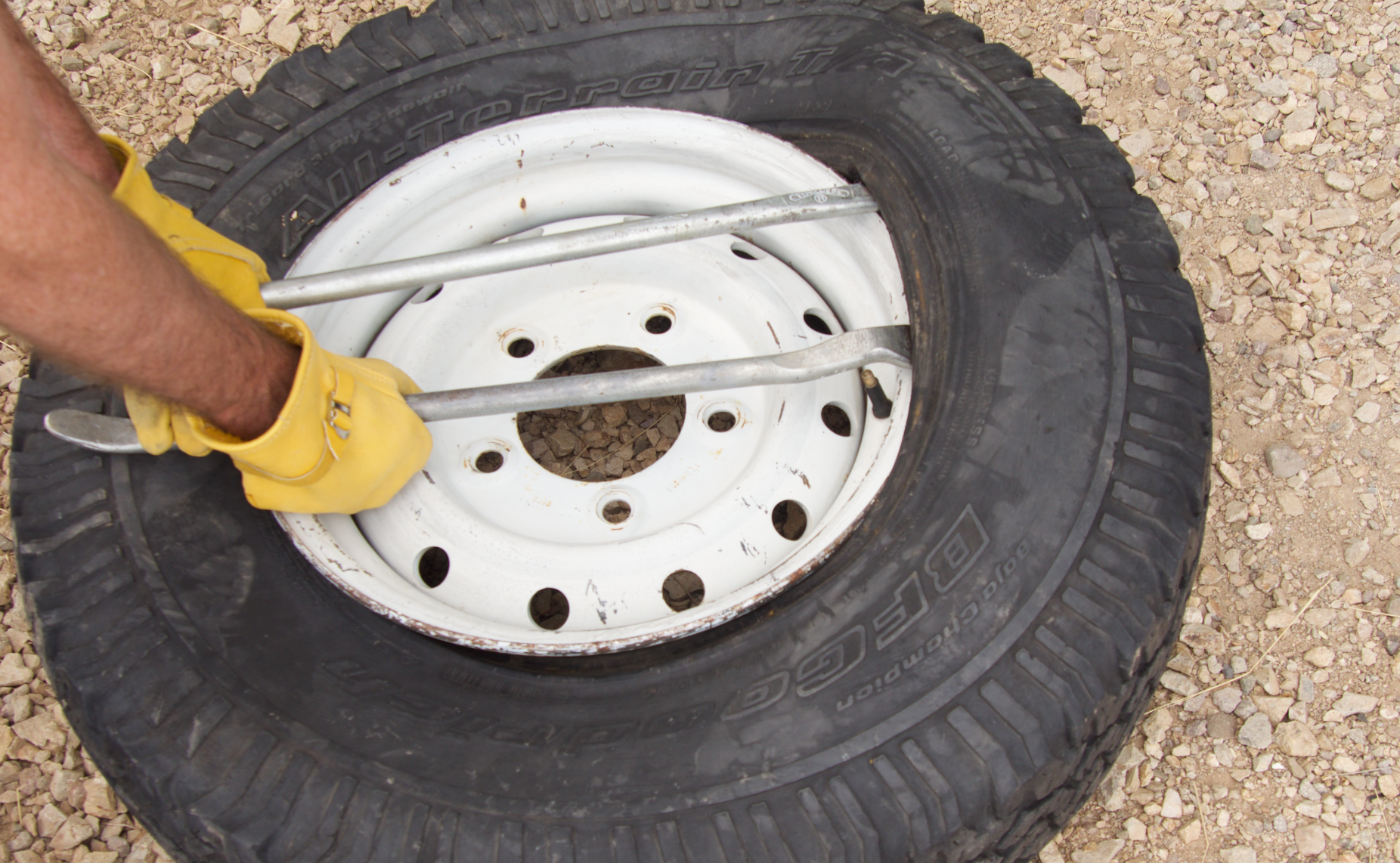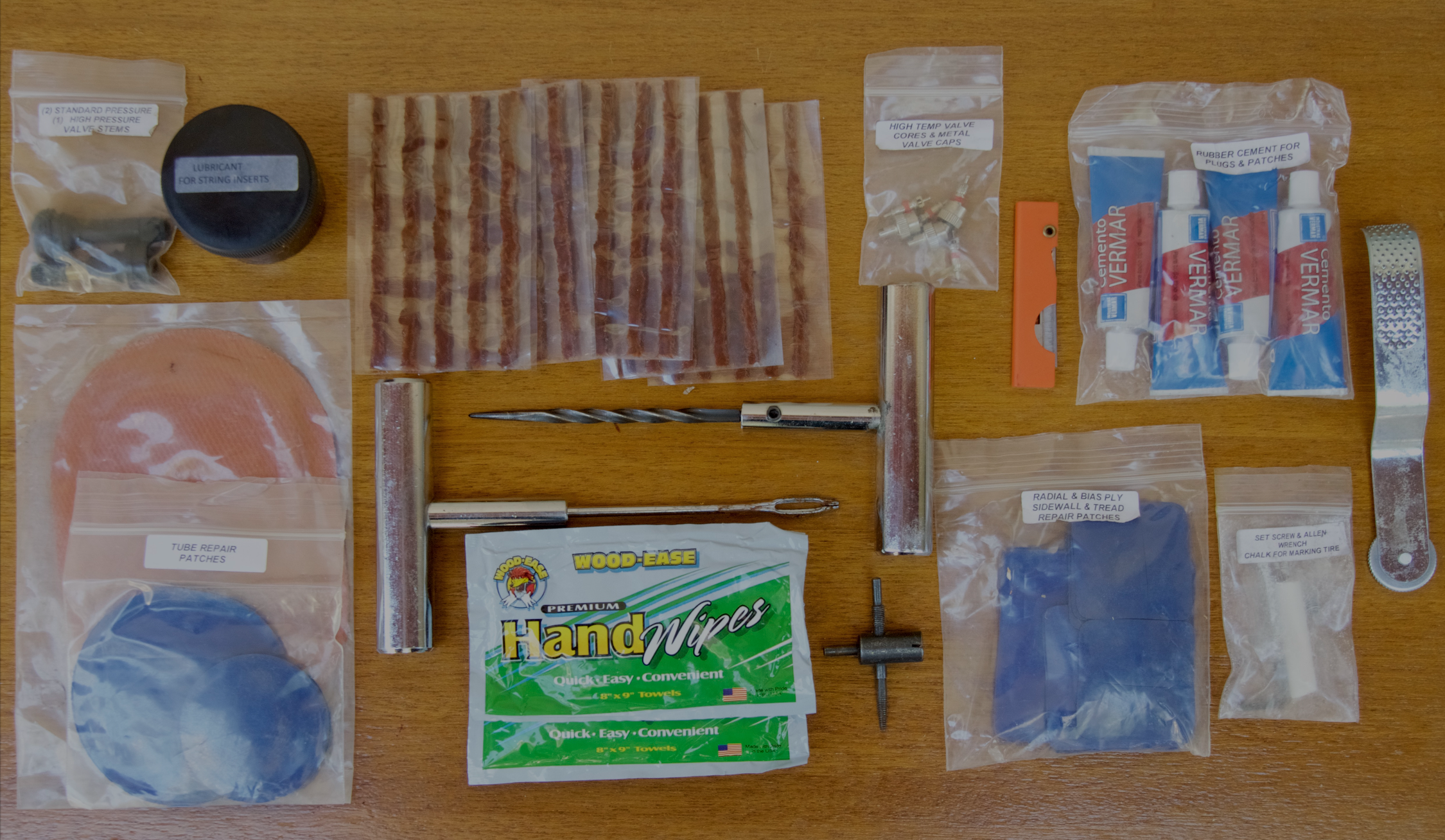
Overland Tech and Travel
Advice from the world's
most experienced overlanders
tests, reviews, opinion, and more
Tire repair in the field
“Stop!”
I’d heard the unmistakable hiss of a punctured tire losing air, and alerted my partner, who was driving the Ford pickup we were using to conduct road surveys in southern Nevada. Our job took us down scarcely used tracks with significant incursion from creosote bushes, which leave vicious little daggers sticking out around the base of the plant as the perimeter dies off. This was our third puncture today—and it was not yet 8:00 in the morning.
Two minutes later we had the tire repaired and had resumed collecting GPS data. We didn’t even bother to add any air, much less replace the punctured tire with the spare.
Tire failure is by far the number one cause of vehicle breakdowns in the backcountry, whether you are exploring Nevada or Namibia. Yet I’m astonished at how many people still rely on a single spare and maybe a can of fix-a-flat as backup on remote excursions far from AAA. The irony is that the farther you are away from well-traveled routes and outside assistance, the higher the possibility of running into projecting root splinters, knife-edged rocks, or even an off-camber rut that can pop a tire bead right off the rim and deflate it instantly.
Why not be prepared, and self-sufficient? With a few tools, a good air compressor, and a proper repair kit, you’ll be able to repair any tire mishap short of a shredded blowout and be on your way.
Most tire problems result from simple punctures in the tread area, where the tire actually contacts the ground. Close to civilization, likely culprits include nails, bolts, and screws. Farther afield, you might run afoul of those creosote daggers or any number of other biological or geological hazards. At higher speeds, punctures typically occur on the rear tires—the front tire rolls harmlessly over a nail or screw lying flat, but pops it into the air where it can land pointy end up just as the rear tire passes. At low speeds, it’s more often the front tire that will find some projecting bit. A nail that embeds itself in a tire might not make its presence known for hours, since it forms a partial plug and slows deflation. A root end is more likely to puncture and pull out, causing rapid loss of air and possibly an audible warning.
The easiest and quickest way to repair a simple puncture is with a plug kit (which is what we used in Nevada). A tire plug comprises a short length of rubber-adhesive-impregnated nylon yarn, which is inserted into the puncture with a special tool, after reaming the puncture with another tool. Cheap plug kits that include tools with plastic handles are available everywhere, but skip them—plugging involves a fair amount of force, and you don’t want to push very hard on a plastic-handled tool embedded with a steel rod. High-quality plug kits with sturdy tools and better plugs come from Safety Seal and ARB. By far the most comprehensive tire repair kit I’ve used is the Ultimate Puncture Repair Kit from Extreme Outback, which includes not only plugs but an exhaustive assortment of patches, spare valve cores, valve stems, a valve core tool—everything you’d need to be self-sufficient on any trip up to and including a global circumnavigation.
The basic tools in a plug kit comprise the plugs, a reamer resembling a round file, and an insertion tool that has a large, slotted eye at the end. How do they work?
High-quality plug tools from Extreme Outback.
Picture yourself at the side of the trail with your plug kit and a slowly collapsing tire. You can jack up the vehicle and remove the tire and wheel if access is limited, or leave it on and slowly roll the vehicle while looking and listening for the source of the leak. Let’s assume you spot a nail head embedded in the tread, and it is accessible. The first step to repair the hole is to prepare the plug in advance, to minimize leakage. Pull a plug free from its cellophane packaging—you’ll find it ridiculously difficult due to the adhesive, but surprisingly it doesn’t stick to your fingers. Pinch one end flat, and insert it into the eye of the insertion tool; pull through to its midpoint. You’ll have to pull quite strongly to get it in there. Your plug kit should come with a tub of lubricant; once the plug is positioned in the tool dunk the end in it to adhere a small glob to the plug right where it goes through the eye of the insertion tool.
Now you’re ready to prepare the hole. With a multitool or pliers, yank out the offending bit (the ARB kit thoughtfully incudes needle-nosed pliers). The next step is completely unintuitive: You’re going to make that hole bigger, so the plug can fit. Insert the reamer into the hole—it might take some real shoving—then work it in and out briskly a few times. Don’t be gentle; move it around and twist back and forth. If the puncture is in the tread area you’ll be able to hear and feel the steel belt as the reamer works through it. You’re not damaging the belt, merely pushing the steel strands apart enough to get the plug in.
Once it moves back and forth easily, set it aside. Insert the tip of the tool and the plug into the puncture. Again you’ll need a strong shove to get the tip and the doubled plug into the tire. Push until just a half inch or so of the tips of the plug shows above the tread, then pull the tool straight back out—no twisting on this. The split edge of the eye will first pull the middle of the plug back into the puncture, packing it tightly with vulcanizing material, then free the plug so the tool pulls out, leaving the plug in place and the puncture instantly sealed—no waiting for glue to dry. (The ARB insertion tool incorporates a collar that prevents you from accidentally shoving the plug all the way into the tire.) Trim the plug as flush as possible with a knife or razor blade, and you’re finished. The tire manufacturer will warn direly that this is a temporary repair, but I’ve known tires with just a few hundred miles on them repaired thusly that went on to live out their full tread life. If the tire has deflated enough so that pushing on the insertion tool just pushes in the face of the tire, add some air with your compressor to give it more resistance.
Push the plug in until the ends stand just clear of the tread.
What if the hole is larger in diameter than one plug will seal? Try two—or three, or four. My friend Tim once repaired a sidewall split with no fewer than five, and it got him back to civilization. While we’re on sidewalls, note that a plug repair there really should be considered an emergency fix only. The sidewall, even on a sturdy all-terrain tire, lacks the structural integrity of the belted tread area—it’s designed to flex, and can’t support the plug as well. Nevertheless, a sidewall plug repair should hold long enough to get you back. (Also note that, as excellent as plugs are, they won’t seal every puncture. Recently on a trip to Mexico a friend holed a tire with a sharp branch right at the corner of the tread and sidewall. The result was a flapped triangular hole that I simply could not get to seal, even with three plugs. It happens.)
Tim’s five-plug repair notwithstanding, a much better way to repair a sidewall split (sidewalls collect splits from rock gashes and pinching more often than they do simple punctures) is with a patch on the inside of the tire. To do that you’ll need access to the inside, which means you’ll need to break the bead, a procedure that sounds alarming but really doesn’t break anything.
The inside edges of an automobile tire, where they grip the rim of the wheel and seal the air inside, are each reinforced with a very stiff wire cable embedded in thick rubber—the bead. The wheel is made with a corresponding groove running around its inside and outside edge. When your local Discount Tire store tech mounts a tire, his fancy machine first levers the tire over the rim so the beads are inboard of the grooves. He then applies a sharp blast of high-pressure air, which pops both beads outward and into their respective grooves. The tire can then be fully inflated. The grooves hold the beads very tightly—even running for some time on a flat tire will rarely unseat them.
When your tech needs to remove a mounted tire, his machine pries the beads loose with a powerful automatic lever. In the field, you’ll need to be more creative. Trust me, just jumping up and down on a deflated tire won’t work. (Important note: Those of you with shiny alloy wheels—or shiny steel wheels for that matter—will find that some of the following techniques might scratch and gouge them. I hereby absolve myself from responsibility.)
The first step is to remove the valve core to ensure the tire is completely deflated and to easily let out additional air as you compress the carcass. Both the Extreme Outback and ARB kits come with a valve core removal tool. Mark the tire and wheel with chalk or anything handy, to make sure you re-install it in the same place and don’t mess up the balance (the EO kit includes chalk). To “break” the bead you need to apply inward force to the sidewall of the tire as close as possible to the edge of the rim, in order to force the bead out of its groove. One effective way to do so is to lay the tire and wheel on its side under your vehicle’s bumper, then position a Hi-Lift or bottle jack with the base plate on the tire and the lifting tongue or post under the bumper. Crank up the jack and the base plate will push the bead out of its groove. You generally only need to do this in one spot as the bead will easily pop out of the rest of the groove when stood on. Always break the bead on the outside of the wheel first; the groove on the inside has a ramp that makes it more difficult.
An elegant enhancement to the Hi-Lift technique is the Extreme Outback Beadbuster, which attaches to the jack’s base plate and incorporates a curved spade to precisely bear against the tire close to the rim, reducing stress on the sidewall. The opposite, cruder end of this spectrum is to lay the tire on the ground and simply drive over one edge of it with the help of a spotter. Effective, but a bit hard on the tire.
The Beadbuster makes beadbreaking with a Hi-Lift jack easier on the tire.
By far the quickest—and most stylish—way to break a bead is with the Australian-made Tyrepliers. This cunning tool, which adjusts to fit wheels up to 19 inches in diameter, frees the bead using good old Archimedean leverage. It’s nearly foolproof, and so universally respected that it carries a NATO stocking number. I’ve lost count of the onlookers and students I’ve amazed by popping the bead on a tire in about ten seconds flat. You stand on the tire and use one foot to push the fixed hook of the tool under one edge of the rim, then work the lever hook under the opposite side with the paired handles. Push down on the lever handle and voilá. It’s not only fast, you’re bearing only on the actual bead, so damaging the sidewall is virtually impossible.
First lever both hooks of the Tyreplier under the rim.
Then push down on the outside lever to force the bead out of its groove.
Once the first bit of bead pops free of the groove, it’s generally possible to stomp the rest of it out around the circumference of the rim. If that doesn’t work, reposition the jack or Tyreplier.
Once the outside bead is free, turn the tire over and do the same to the inside bead. The tire will now be loose in the well of the rim, but you still will not have access to the inside of the carcass. For that you’ll need a pair of automotive tire irons, which look like and are just butched-up bicycle tire irons about two feet long, and work exactly the same way. (Extreme Outback's Deluxe model is the best I've used.) Start near the valve stem (again, you’re working on the outside of the wheel), insert one iron and lever the tire over the wheel edge. Insert the next one near it and lever that section of the tire over. Leave the first iron in place as you proceed around the tire until it pops free. With one side of the tire off the rim, you’ll have adequate access for most repairs; if not, you can use a tire iron and a dead-blow hammer to take the tire completely off the wheel. But getting the second bead over the edge is significantly more difficult.
Using tire levers to pull the bead over the rim.
If the sidewall split is short, you can simply patch it from the inside; again think glorified bicycle repair. The patches in the Extreme Outback kit cover a range from small to terrifyingly huge. If the split is severe, you’ll want to stitch it to hold the edges together and reinforce the patch—yes, more or less like a surgeon would do with a bad cut. I use a cordless drill, or an awl with a cutting edge, to make a line of small holes on either side of the split, an inch or so apart and a quarter inch from the split, then stitch it together tightly with whatever is handy. Small-diameter, flexible wire works best; heavy fishing line works too but is difficult to knot. (I’ve heard of people using dental floss, which might work if it were tripled or quadrupled.) With the slice secured, you can roughen the area behind it, spread cement on both tire and patch, wait until dry, then apply (obviously your patch needs to cover the stitch holes). This is another repair to be considered only in a fix-it-or-walk-home situation, but I know of stitched tires surviving dozens of rough miles. Incidentally, if you have a tire off the rim and you’ve done any plug repairs, note that now is a good time to trim the plug and install a patch behind it for ultimate security.
Now you have to put everything back together. Starting this time opposite the valve, use the tire irons to pry the bead or beads over the rim and back into the well of the wheel, so you have a loose tire completely inside the rims. Remember the fancy machine the tire tech used to blast air into the tire and seat the beads? Again, we’re going to improvise.
There’s a long-standing myth that you need a very large volume of air (or hold-my-beer pyrotechnics with starting fluid; see below), to reseat beads. But I’ve done it with very small compressors and proper technique—as long as the wheel is not too wide for the tire. If you run showpiece alloy wheels ten or twelve inches (or more) in width, so your tires’ sidewalls barely protrude past them, you might have a devil of a time reseating beads in the field—and you’ll also stand a much greater chance of damaging a wheel rim on the trail, since there’s no protection offered by the sidewall. The steel wheels on our Land Rover 110 and FJ40 Land Cruiser are 6.5 inches wide, and I can easily reseat beads on 255/85/R16 BFG tires (higher-profile tires help as well, with their more flexible sidewalls).
I mentioned that I’d reseated beads with very small compressors, but the larger volume of air you have, the easier and quicker the process will be (see sidebar on compressors). A CO2 tank will work very well, but be aware that CO2 can leak out of tires over time.
Here’s how it’s accomplished. Stand the tire and wheel upright, and center the tire as evenly as possible in the wheel with your chalk marks aligned. If tire and wheel are well-matched the tire’s beads will naturally bear against the inside of the grooves and form a partial seal on their own. Use water, with some detergent in it if you have it, to thoroughly soak the perimeter of each bead—this functions more as a lubricant than a seal. In a pinch any liquid is better than nothing—my nephew reports that Keystone Light beer works well, which is as far as I’m concerned the best possible use for Keystone Light.
Your valve core is still out, right? Apply the air chuck to the valve and start inflating. (Note: You’ll need a chuck that doesn’t require the valve core to be in place to operate.) Check yours first. If the tire is not centered properly you’ll see a lot of bubbles in one spot; stop and reposition. If the seal is good you’ll see the tire’s walls expand slowly until, with a distinctly alarming metallic PING, they will seat in turn, usually the inside one first because of the ramp. Release the chuck—air will rush out but the beads will stay put. Re-insert the valve core, inflate, and you’re finished.
Some bush mechanics suggest running a ratchet strap around the circumference of the tire and tightening it prior to setting the beads, the idea being that it will push the beads outward and making sealing easier. I’ve tried it with and without and never noticed a difference, even with a big strap—and to me the strap just adds one potentially dangerous bit to fly off if something goes wrong. The other seating technique is the infamous starting-fluid routine, which involves spraying starting fluid or another flammable aerosol around the bead of the tire laying on the ground, then tossing in a match to create a minor explosion that blows the beads onto their grooves in a split second. When this works it is a crowd-pleasing spectacle, but search YouTube for videos and you’ll find plenty of crowd-pleasing, spectacular failures as well. I prefer the more civilized approach.
I only failed to reseat a bead once in public, at an Overland Expo. It was embarrassing, and I didn’t discover the reason until later. The wheel I was using was very rusty on the inside, and simply let too much air leak to re-seat no matter how hard I tried. Once I cleaned off the rust and repainted the wheel I never had trouble again.
There is another situation in which you might find it necessary to reseat a bead. Occasionally on very rough trails a rut or rock will catch the side of a tire with enough force to knock a bead loose and produce a startling whoosh as the tire deflates. This seems somewhat more likely to occur if you have aired down to enhance traction (or if you’ve been indulging in a bit of Baja 500 hooning). Frequently only one bead—usually the outside one—will be pushed off. While it is sometimes possible to reseat the bead with the wheel still on the truck, you might find it necessary to remove the wheel and actually unseat the opposite bead to get the tire to sit properly for reseating with an air compressor.
Once you’ve mastered the art of demounting tires and reseating beads in the field, dealing with simple punctures will seem like child’s play. That day in Nevada? If memory serves, we collected several more punctures before the day was out, and each one was repaired in a couple of minutes. We never even considered putting on the spare tire. That would have been way too much work.
Just part of the contents of the Extreme Outback Ultimate Puncture Repair Kit (about $100).
. . . and the also-excellent ARB kit, well-organized in a blow-molded case ($42).
One last note: The plugs that are included with the ARB kit are really too large in diameter for most punctures, and make the job more difficult than it needs to be. Do yourself a favor and look on Amazon for extra-thin Safety Seal plugs to augment the kit. They help with the Extreme Outback kit as well.
Trust . . .
For the first ten or so years of our marriage, not another human besides me touched the mechanical components of our vehicles. I rebuilt the engine of a BMW 2002 we bought in pieces in boxes; I changed the clutch on our first 2wd Toyota pickup literally in the street in front of our first house; I swapped the engine and transmission in our FJ40; rebuilt the knuckles on our FJ55—many more fairly major jobs besides the gentle but regular tides of normal maintenance.
Mind you, I am most definitely not an expert mechanic. “Competent amateur” would be the highest category with which I’d be willing to label myself. Nevertheless, while we were still in school and then striving to build careers freelance writing, and thus too poor to afford “real” mechanics, I was able to keep our various vehicles mobile.
Things began to change once we started making better money, and changed more quickly once we’d established ourselves as writers, and later when the Overland Expo began to grow so quickly. I found myself in a position in which I actually saved money by taking our vehicles to a mechanic, so that I could continue my main functions in the business. Fortunately, by that time we’d found (and made a dear friend of) a master Toyota mechanic named Bill Lee, someone in whom we could place implicit trust on any mechanical matter. We got to know him as a mechanic at a Toyota dealership, when he rebuilt the engine of the FJ55 we’d just bought that had been traded in. Once he opened his own shop, we didn’t need to think twice when we needed work on the 40 or any of the Toyota pickups we cycled through.
Then the bastard moved. First 250 miles away, then 500, to northern New Mexico. We shipped the FJ40 to him when it was time for a complete powertrain renewal, but for more run of the mill procedures that’s a bit much. So on advice of another friend we took a 2002 Toyota Tacoma Prerunner we had bought for the business to a prominent local shop for a major service.
Something over $2,000 later it was back (and had me reconsidering whether we were actually saving money with this approach . . .). All seemed well, but several months later we decided the Prerunner was just not the right vehicle for what we needed at the Expo, and sold it to a friend of Bill, who needed a solid truck on which to mount a Four Wheel Camper, but who did not require four wheel drive.
Needless to say, Bill gave the truck another thorough going over with his own critical eye—and sent me an email that was disappointing. Checking over what had been done by the Tucson mechanic, he found a $5 generic PCV valve for which we had been charged the Toyota price ($25.56), and a Toyota part—a window master switch—which lists for $403.20 but for which we paid $535.71, not counting labor. Also, the intake boot, which was rotten and torn and should have been replaced, had been “repaired” by wrapping it with electrical tape.
Sigh . . .
Is this what so many vehicle owners have to put up with on a day-to-day basis? Not knowing if your mechanic is trustworthy? I know it’s possible to make an honest living as a mechanic because Bill does so, even in a remote one-horse New Mexican town which is (did I mention this?) 500 miles away from a perfectly decent supply of loyal customers in Tucson.
Trust. Notice that once it has been compromised by a single incident, it is essentially gone? One can be pretty certain that a shop does not overcharge on a factory part just once, or install an aftermarket part and charge a factory price for it just once, or bodge a repair just once. It’s like discovering a lie told you by a friend or business associate. Once you have that proof of duplicity you quite rightfully doubt everything.
Fortunately the diesel mechanic who takes care of our Ford F350 has proven to be not only competent but honest to a fault. But a 50-percent success ratio is nothing to brag about. In the meantime, I wonder if I lodge enough false complaints about Bill Lee on Yelp, he’ll lose business in Farmington and have to move back here?
Headlamp restoration
I hate plastic headlamps.
Mind you, I’m delighted with the output and beam pattern of most modern headlamp* assemblies, which are as far ahead of sealed-beam technology as sealed beams were ahead of acetylene. But plastic is plastic, and while you might argue that polymer headlamp lenses are more resistant to stone chips than glass lenses, they eventually will discolor, renedering them semi-opaque and compromising their otherwise excellent performance—and also making them look like crap.
Our 2002 Tacoma Prerunner’s lamps were already well into the jaundiced phase when we took it over from my brother, and I recently decided to do something about it. So I went to the Griot’s Garage site.
I remember the early days of Griot’s, when most of their offerings were exotic and superb tools not available at Sears. My first exposure to Facom and USAG tools were through Griot’s. However, as time went on, Richard Griot (pronounced gree-oh) obviously discovered that the real money was in boutique car-care products such as cleaners, waxes, polishers, clay bars, and a myriad of accessories down to the level of oversize Q-tips for cleaning those pesky crevices in your alloy wheels. Only a few token mechanic’s tools remain among the latest offerings, but you can choose from among no fewer than five power buffers.
Still, any product I’ve bought from Griot’s has been first rate, so I ordered their headlamp restoration kit and set out one afternoon to see how it worked.
And it did, excellently. The entire process—masking the surrpunding trim, wet-sanding the headlamp lenses until the slurry turned from yellow to white, drying them off and prepping with an alcohol pad, and spraying on the new coating—took less than 30 minutes, and it was satisfying to watch the lenses, alarmingly cloudy-white from the wet sanding, turn sparklingly clear under the coating (said to be good for 24 months).
Was it worth $29.95? In terms of sheer results and ease of application, sure. Yet I found myself bemused by the contents of the box, which totalled:
One two-sided sanding pad, helpfully labelled “driver side” and “passenger side”
A couple of lint-free paper towels
Three alcohol prep pads
One 1.5-ounce spray can of the magic coating, good for exactly one set of headlamps
Coating aside, it would be stretching it to claim there was a dollar’s worth of material in the box. That leaves twenty nine bucks for an ounce and a half of coating. It works, but I suspect Griot’s is printing money on this kit.
*As an aside, technically the correct term for the device that lights the road in front of your vehicle is headlamp, not headlight.
Griot's Garage is here.
Building a zero-hour F engine
If you’re only going to rebuild an engine every 20 years or so, you might as well do a thorough job. That’s been the guiding principle for both me and my master Toyota mechanic and friend Bill Lee, as he disassembled and inspected the six-cylinder F engine and transmission of my FJ40 (see this post for background). Actually it wouldn’t have mattered whether or not it was my guiding principle—Bill would have refused to do it any other way.
The engine had been showing distinct signs of power loss, although oil consumption was not unusual. Teardown revealed one certain cause: the camshaft was badly worn, and on a couple cylinders was clearly not producing much lift on the intake valves. Bill’s explanation for this was illuminating. Apparently on start-up of an F engine, the cam is the last part to receive oil from the pump. Generally this is no problem as residual oil provides plenty of lubrication—unless the vehicle is parked for long periods, in which case the oil will drain away from the cam lobes. The cam will then be without oil for the first 10 or 15 seconds after starting. And—surprise—for several years my FJ40 has seen long periods of idleness while we were traveling overseas, using the Tacoma and Four Wheel Camper for journeys in North America, and putting miles on various long-term review vehicles. Shame on me. (Bill suggested changing to an oil from Joe Gibbs Racing that displays cling properties superior to standard oils. And driving it more.)
Once Bill had the engine disassembled entirely, he called and we had a chat. The cylinders were in excellent condition, still within specs, even still showing factory cross-hatch honing marks. The pistons came right out, Bill reported—no wear ridge at all.
However. The bores showed vertical scoring, and Bill and I were pretty sure where this originated, as I’d discovered a surgical-strike rodent intrusion in the air cleaner last year, the cleaner itself chewed through and remnants of comfortable rodent accommodations in the housing. I cleaned everything out, but it’s likely some debris had been sucked into the engine in the meantime. (Mystery: After the incident I put hardware cloth over the opening, but Bill found the air cleaner chewed again. Either one got in during the day or two before I installed the screen—likely—or I had the Harry Houdini of mice.)
The consensus from the machine shop was that the scoring could not be completely honed out while keeping the bore stock, so we decided to bore the cylinders and install new pistons, Japanese-made units from ITM (Toyota pistons are no longer available for the F engine).
The main bearings were in good shape, but given the need for machine-shop work anyway we decided to turn the crank and install one size over bearings. Bill also suggested balancing the components—not a huge deal given the inherent primary balance and even firing order of an inline six-cylinder engine, but every bit helps. The machine shop matched the weight of all the connecting rods to the lightest one by judiciously grinding away material on the caps. (Hey! Less weight means more horsepower!)
Meanwhile, the head has been given a valve job, and equipped with new OEM valve guides and springs—which Bill had to source piece by piece from several dealers around the country. Factory parts such as these are becoming more and more rare. The replacement cam is an aftermarket item; however, it’s a brand Bill has used before with good results. The lifters as well are aftermarket Japanese manufacture. (The last few new OEM F cam/lifter sets sold for near $1,000; this set totalled about $400.)
What else? Bill wisely recommended replacing the oil pump, even though it was working fine. Toyota no longer makes the F oil pump, but the (improved) model from the 2F is still available—however, installing it requires a 2F oil pan as well, so that is in hand. New OEM timing gears will ensure precise cam timing.
Once everything is put back together (with a one-of-few-remaining factory gasket kit), we’ll have an essentially zero-hour engine. It should in fact be better nick than when I bought the vehicle from its original owner in 1978, with 24,000 miles on it.
The header was in good shape, and so ceramic-coated for re-installation.
Next up for attention will be the H41 transmission and transfer case.
Battery welding done right
The magic of battery welding has been known to field mechanics for years now, and one of the most popular classes at the Overland Expo is the hands-on introduction to the skill, taught by experts such as welding wizard Tim Scully. Briefly, by combining several standard automotive batteries in series—that is, positive terminal to negative terminal, in a chain—you create in effect one large 24V (with two batteries) or 36V (three batteries) cell, and this produces enough power to weld a lot of things that can be prone to breaking on vehicles used in rugged conditions: shock and spring mounts, motor mounts, ancillary brackets, roof racks—the list is endless, and full of items that can bring a trip to a sudden halt.
Until now, most impromptu battery welding has been jury rigged with standard jumper cables. While this works, it is far from ideal. Jumper-cable wire is cheap stuff designed for a few second’s starting duty at a time; its coarse strands are inefficient at conducting the power produced by series-connected batteries. And the toothed clamps, although adequate for attaching to battery terminals, are poor for gripping slender welding rods. In addition, you need a way to connect the batteries to each other, which either requires another set (or two) of jumper cables, or yet more jury rigging with your existing battery leads.
All that just ended, thanks to the Trail Weld kit, developed by Tim Scully himself. Tim evaluated the compromises that go into the normal battery-welding setup, and fixed them all.
- The cables are now fine-strand, four-gauge Temco welding wire, with 360-degree crimps on all fittings. A 12-foot length on positive and negative leads allows you to put a safe distance between the batteries and sparks. The flexible cable makes controlling the clamp and rod much easier.
- The positive lead ends in a proper welding-rod clamp, and the negative lead ends in a dedicated ground clamp.
- Two short leads of Temco wire make quick work of connecting batteries, and reduce voltage loss.
- All battery connections are high-quality terminal clamps, greatly enhancing conductivity and thus efficiency.
- All connections are color-coded with heat-shrink wrap.
- A selection of correctly sized welding rods is included in a plastic protective case.
- A pair of self-powered auto-darkening goggles is also included.
- Available containers range from a simple bag to a .50-caliber ammo can to a Pelican Case.
The complete system is so efficient that Tim reports two batteries are sufficient to weld material that requires three if using jumper cables. As he told me, “If you are using three batteries you’d better be welding at least quarter-inch-thick stock.” Since an increasing number of overland vehicles these days are equipped with two batteries, that means you can be completely self-sufficient for field-welding repairs.
For welding amateurs such as myself, the auto-darkening goggles make all the difference when welding with rod, as there’s no pre-positioning the rod at the correct gap and then fumbling with a standard goggle or, worse, a jury-rigged square of welding glass taped to a cardboard face shield, as I’ve always carried. (Of course you’ll still want face, arm, and hand protection.)
For more information, visit the Trail Weld site, here. At the upcoming Overland Expo WEST, Trail Weld kits will be on display during the welding classes, and available for purchase at the 7P booth. Highly recommended.
A Marv in the palm of your hand
I once knew a mechanic named Marv. (Could there be a better name for a mechanic? Picture him: Brylcreemed black hair combed back in a bit of a pompadour; grey trousers and shirt with “Marv” on a shoulder patch, oil-stained loafers, and perfect white socks. That’s Marv.)
Marv had a shop in which he built hot rods for fun while doing ordinary mechanical work to pay bills. He had the contract to maintain J.C. Penney’s furniture-delivery trucks when I was driving them after high school.
The thing about Marv was, vehicles talked to him. I don’t think I ever saw him have to do more than listen to a truck or car for a few seconds before perfectly diagnosing its issue. “Throwout bearing,” he said into my window when I pulled up in a truck that was making a strange noise during shifts—before I even parked or mentioned the specific complaint. “Front U-joint,” “Water pump,” “Burned exhaust valve”—those are Marv diagnoses off the top of my memory. I once brought in a truck that had started running rough, and he said, “The timing’s slipped.” Did he go fetch his timing light? Nope—he pulled out a half-inch wrench, loosened the nut on the V8’s distributor, turned it with his head cocked to the side, revved it a couple of times, tightened the nut, and said, “There you go.” That time, one of my co-drivers (Vern—could there be a better name for a furniture-delivery man?) was with me. He knew Marv well, but not well enough.
“What’s the timing supposed to be?” Vern asked.
“About seven degrees before top dead center.”
“And how close do you think you got to that?”
Marv said nothing, just fetched his timing light and, well, I bet you can guess the rest by this point. Some time after that I was summarily fired for rapelling off the J.C. Penney warehouse roof (just for fun—a story for another time), and I lost track of Marv and his preternatural skill.
Today? Today any rookie with 20 bucks, an Amazon account, and a smart phone can enjoy a near-Marv-like mind-meld with an OBDII-equipped vehicle two days after clicking “Add to cart.” I know, because I finally ordered a KingMansion ELM 327 wi-fi-enabled OBDII reader that sends all sorts of interesting and useful information to my iPhone, including stuff even Marv couldn’t have determined (although I doubt it could identify a faulty throwout bearing). The only catch is, you’ll also need a compatible app for the phone—cheap if you buy something like the $10 OBD Fusion in the iTunes app store, more expensive if, like me, you don’t pay attention and wind up with one that also synchs with the phone’s accelerometer to record 0-to-60, G-force, and lap times. If I ever decide to try for a new Tacoma/Four-Wheel-Camper lap record at Riverside, I’m all set.
In case you don’t pay attention to such things, OBDII (for On Board Diagnostics) is a standardized system and port (in the U.S.), mandatory on all passenger vehicles since 1996. It allows the vehicle’s CPU (central processing unit) to communicate information about the engine’s emissions (the original intent), instantaneous fuel usage, actual engine temperature, engine load, air intake temperature, and much more, depending on what the vehicle’s manufacturer chooses to make available.
Most useful for owners, however, is the ability to read trouble codes when the dashboard energizes that annoying and oh-so-vague “Check engine” light, which could indicate anything from imminent disaster to something utterly harmless such as a failed reverse lockout switch (this happened on our old Tacoma).
I followed the instructions on the absurdly inconsequential-looking ELM, and within minutes the Tacoma was assuring me all was well fault-code-wise. Other functions such as instantaneous fuel mileage (full throttle in first gear with a camper = 7.142 mpg) also popped up and worked perfectly.
If you do hook up an OBD scanner in response to the check-engine light, don’t expect a little pompadoured Marv to pop up on the screen and tell you what’s wrong and how to fix it. All you’re going to see is an alphanumeric code (or perhaps several). You need a guide to tell you which of a mind-boggling array of faults you are experiencing. It might be, say, code P0812, indicating a reverse switch malfunction, which you can ignore if you’re in the middle of nowhere, or, say, P0304, indicating a misfire in cylinder four, which you would not want to ignore. Codes that begin with a P0, P2, or P3 are universal codes; those that begin with P1 are manufacturer-specific. Many websites have been created solely to list and explain OBDII codes. (Toyota has a professional site here that caters mostly to mechanics, but you can apparently buy a temporary subscription to retrieve current technical bulletins and OBD codes. I write “apparently” because it’s only compatible with PCs—and only using Internet Explorer, for God’s sake. C’mon, Toyota.)
By far the most likely scenario is that even after you look up the code you’ll be presented with some utterly incomprehensible diagnosis, such as P0608, “Control Module VSS output A malfunction.” The reason for this is that, when the people in charge were programming what the standardized OBDII sensor would monitor and flag, they decided they wanted it to be the equivalent of the most hypochondriac human being on the planet—just to be safe, and to give car dealers plenty of work. So—I have no proof of this yet, but I’ll get to the bottom of it—I’m virtually certain they kidnapped my mother, hooked up electrodes to her in a secret research facility in Detroit, and remarked admiringly, “Wow—we need at least 360 potential fault codes.”
Whatever the case, you’ll have to decide whether one of these obscure codes is reason to abandon a trip and head to a mechanic. My own reaction, if the truck were running well with no outward signs of trouble, would probably be to mutter, “Yes, mom, whatever you say,” and keep right on driving.
The amazing ClampTite
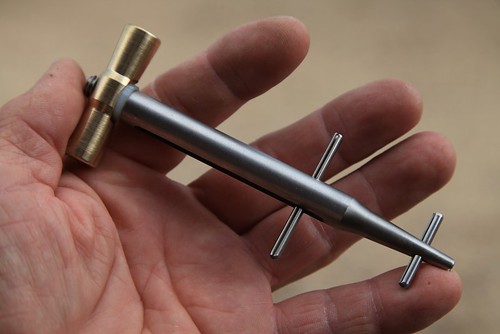
I know, I know—I’m starting to sound like Ron Popeil. But it’s been some time since I used a tool as cunning as this little device, which can do everything from replacing a broken hose clamp on a fuel line or seizing a rope end to repairing a stress-fractured luggage rack on a motorcycle or splinting a broken tie rod on a Land Rover.
But wait, there’s more! The ClampTite uses ordinary safety wire you can buy with the tool, or almost any on-hand substitute in a pinch, including fence wire and even coat hanger wire, to securely wrap just about anything that needs to be fastened or immobilized. And the size range it will handle is essentially limited only by the length of the wire.
You might think you could approximate what the ClampTite does with a pair of pliers and some twisting, but trust me, you wouldn’t be able to apply the amount of tension available through the tool’s threaded collar. Look at this sample of both a single and double wrap on a length of rigid PVC pipe. I tried and failed completely to get that much compression with an ordinary hose clamp.

The ClampTite can make either a single-wire or double-wire clamp (see above). With a single wire you can use as many wraps as necessary, although, depending on the material, friction will start to overcome the ability of the tool to adequately tighten the wire if you overdo it. On a radiator hose like I used for the test, a single wrap of doubled wire is more than stout enough; if you were repairing, say, a split axe handle you could use several wraps of a single wire, then repeat in several places along the split to completely secure it. The same procedure could secure a Hi-Lift jack handle along a broken tie rod, or . . . you name it. The potential applications are endless.
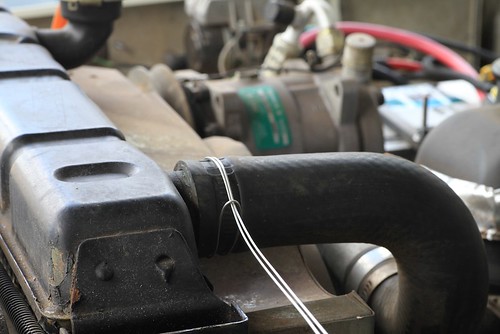 Begin a hose clamp by doubling a length of wire and wrapping it like so.
Begin a hose clamp by doubling a length of wire and wrapping it like so. Wrap it again and through the loop.
Wrap it again and through the loop.
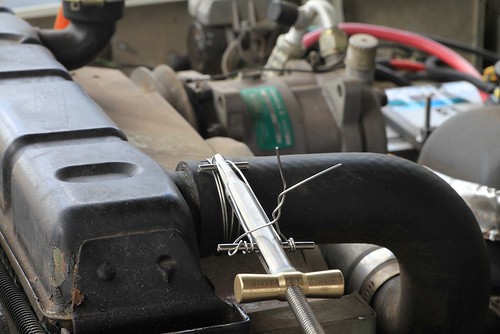 Attach the ClampTite, secure the ends of the wire, and screw in the bronze nut to tension the clamp.
Attach the ClampTite, secure the ends of the wire, and screw in the bronze nut to tension the clamp.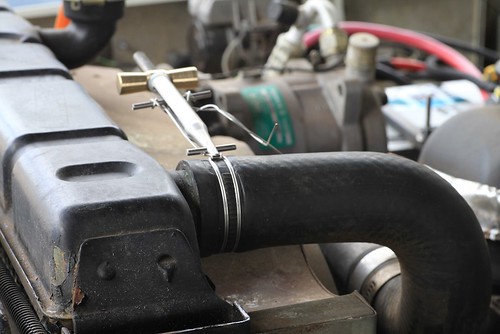 Flip the tool to lock the wire.
Flip the tool to lock the wire.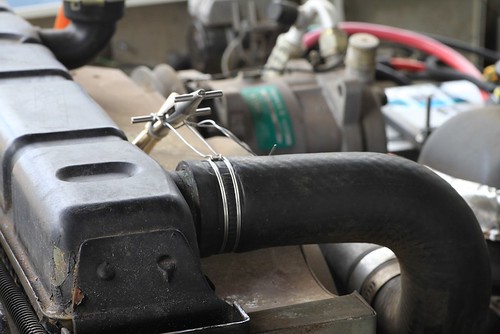 Release the tension on the tool, clip the wires, and . . .
Release the tension on the tool, clip the wires, and . . . . . . you're finished.
. . . you're finished.
I found the ClampTite easy to use. My biggest challenge was keeping the wire lined up correctly while installing a double-wrap clamp, to keep it from overlapping—although that probably wouldn't affect the seal on a radiator hose.
While it’s impressively compact (a larger model is also available), there will be places you simply can’t use the ClampTite. You need to be able to access the trouble spot to wrap it with wire, attach the tool at the spot, and have room to flip it (double wire) or twist it (single wire) 180 degrees to anchor the clamp once you’ve tightened it. But with ingenuity you can overcome many obstacles. Looking around our vehicles, I found a fuel line fitting on a carburetor that would be inaccessible if its hose clamp broke. However, by removing the fitting from the carburetor first and taking off the other end of the fuel line, one could clamp the line to the fitting, screw the fitting back in with the line attached, then re-attach the other end.
I think the ClampTite would be at least as useful on a motorcycle as in a four-wheeled vehicle, if not more so. I’ve seen many more parts fail on bikes due to the higher intrinsic vibrations and necessarily harsher ride. We had Tiffany Coates’s legendary BMW R80GS, Thelma, parked at our place for nearly a year some time ago. Thelma has seen long (200,000 miles), hard use and it shows. Thinking back, I’m sure I could have used up at least a hundred yards of safety wire reattaching various dangling bits on that bike.
ClampTite tools start at just $30 for a plated steel and aluminum model, which would be ideal for a motorcycle. The stainless and bronze unit I tested is $70.
Final note: Unlike the Ronco 25-piece Six Star knife set, ClampTite tools are made in the U.S. And you won’t get a free Pocket Fisherman with your purchase. Sorry.

ClampTite tools are here. Thanks to Duncan Barbour for the tip!
The one-case tool kit, part 1
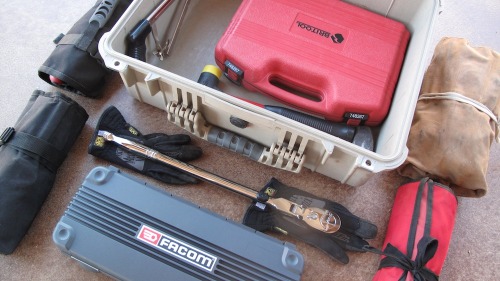
It would be pretty easy to bring along all the tools you’re likely to need on even an extended overlanding trip, covering virtually any repair not involving a new long block. What’s that? Oh—you also want room for, like, food? And maybe a tent and sleeping bags? Hmm . . . now that’s a problem.
The size of tool kit you carry (or should carry) is subject to a bunch of variables. The length of the trip and the remoteness of the route are two obvious considerations. The age of the vehicle is certainly a factor—even reliable vehicles need more attention as they get older. If you can just go out and write a check for a new Land Cruiser every time you leave on a major trip, your need for tools should be minimal. On the other hand there are people like, well, Roseann and me. A brief survey and some arithmetic established that the average age of all the four- and two-wheeled vehicles currently in our fleet—1970 Triumph Trophy, 1973 FJ40, 1974 Series III 88, 1981 BMW R80 G/S, 1982 Porsche 911SC, 1985 Mercedes 300D, and a practically spanking-new 1987 Honda NX250—is 33 years. All solid vehicles, but inevitably in need of attention now and then, especially the . . . (Ha! you were ready for a facile brand quip here, right? Not this time.)

You might think, if you’re utterly mechanically ignorant, that it makes no sense to waste money and space on tools you don’t know how to use anyway. Au contraire—if something goes wrong and you need the assistance of strangers, the least you can offer them is the tools to render that assistance. At a minimum, even on a brand-new Land Cruiser you should carry enough to make what I call generically “rubber repairs,” involving the replacement of pliable things such as fan and serpentine belts, and radiator and heater hoses. These are items that can fail or be damaged even on a new vehicle. A set of standard and Phillips-head screwdrivers, a socket and ratchet set, and a set of combination wrenches will suffice to start (note that for our purposes I consider tire-repair tools a separate subject). But if you want to cover more than first base, you'll need a few additional items.
Okay, so you’re going to buy some tools. You take a look around the web and find, for example, one set of metric combination open/box-end wrenches, from 10mm to 19mm, for $14.95, and another set of the exact same number and size wrenches, from a different manufacturer, for $298 (I am not making up these prices). You’d be forgiven if your brain texts to itself, WTF? We’re not talking about the difference in value between a Corvette and a Carrera here—this is more like Tata Nano versus Aston Martin Vantage. At least with the cars it’s easy to spot a few differences besides the fact that they’re both designed to go from point A to point B. The wrenches don’t even have any moving parts, and appear more or less identical. What gives?
Three factors contribute to the discrepancy: quality, reputation, and pure status.
Quality on even something as simple as a wrench can vary tremendously. Consider what goes into its manufacture:
- What is the alloy used in the steel—plain carbon? Chrome molybdenum? Chrome vanadium?
- How is the tool formed—is it machined, cast, or drop-forged? Drop-forging helps align the internal grain in the steel, increasing strength.
- How is it finished? If chromed to resist corrosion and dirt, what process was used?
- How precise are the tolerances? This is a critical factor in how well the wrench performs—sloppy tolerances increase the chances the wrench will strip a tight bolt or nut.
- Does the box end of the wrench employ the superior “Flank Drive” system pioneered by Snap-on and now copied everywhere? Look for rounded rather than sharp teeth; these bear on the stronger flats of the nut rather than the corners. (The Flank Drive Plus system on new Snap-on wrenches adds the same capability to the open end of the wrench via grooves on the flats. This has been copied by other makers as well.)
- What about ergonomics? Is the wrench long enough to provide adequate leverage (unless it's a shorty designed to fit in tight spaces)? Fully chromed and polished tools don't just look nice and resist corrosion; they're easier to keep clean as well.
- Finally, how socially responsible is the tool? Was environmental protection a factor in the mine-to-maker-to-consumer chain? Do workers in that chain earn a fair wage?
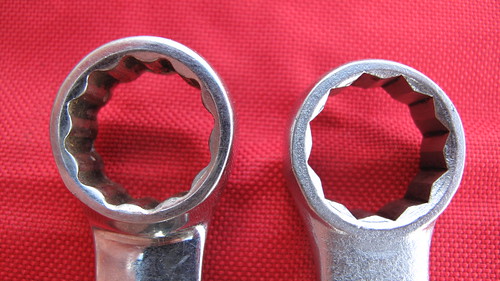 Flank Drive wrench head on the left, standard head on the right
Flank Drive wrench head on the left, standard head on the right
It’s nearly impossible for a consumer to evaluate many of these parameters accurately. A tool marked “drop-forged” could be forged to low tolerances with poor-quality steel. One has to wonder if the wrenches in that $14.95 set were made by a laborer in his or her 60th hour of work that week, and if the smelter or factory do anything to reduce their emissions. It’s sheer common sense that for ten wrenches to be produced in Asia, shipped across the Pacific Ocean, trucked to a Harbor Freight store in Topeka, and sold at a profit for 15 bucks, something along the line had to give: quality, ethics, or both.
That’s where reputation figures into the equation. Although it’s not a guarantee, buying tools from manufacturers with solid reputations for quality at least makes it far more likely you’ll be getting a good product either produced in the U.S. or under decent conditions elsewhere. I’m referring here to such makers as Sears Craftsman, Kobalt, Proto, S-K, and Husky. A set of wrenches from those makers will cost more than $14.95, but it’s very probable the extra expense will be worth it on several levels.

Finally, there’s status. The “boutique” tool makers such as Snap-on (the producer of that $298 set of wrenches), and to a lesser extent Mac and Matco, have transcended reputation and moved on to the level of status symbol. There’s little doubt that that set of Snap-on wrenches (which are, just to be clear, certainly the best on the market) could be duplicated in every detail and sold for much less, but the Snap-on (or Mac or Matco) label adds a premium eagerly paid by both professional mechanics and well-to-do (or savvy, see below) amateurs. The reason is that, tool snobbery aside, these companies have stayed at the very forefront of tool development and quality. If you pay the premium prices for tools from these manufacturers, you can be absolutely certain you're getting the best tools with the most advanced features.
What to buy then? I’ll continue to repeat it for as long as it takes to make it into one of those 1001 Famous Quotes books: If you’ve brought out the tools, something has already gone wrong. Why risk compounding the situation by using cheap tools to try to fix it? I recently read an article on bush repairs in a respected Australian four-wheel-drive magazine, in which the writer opined, “Your tools don’t have to be good, just good enough.” And how, exactly, do you identify that fine line of “good enough” except when one breaks at the worst possible time and you’re left holding a handle and thinking, Hmm . . . not good enough.
So, fine—just go stop a Snap-on truck, hand the driver your AmEx card, and say, “Tool me.” Except that very few of us can afford that option. Instead, I suggest prioritizing.
The most critical component of an automotive tool kit is the ratchet and socket set. This is what you’ll be using for any serious repairs, and its various pieces are the most susceptible to poor quality control. The ratchet head encloses a lot of very small parts that can be put under enormous strain. It’s easy to make a strong ratchet head with a coarse (i.e. 24 or 36) tooth count, but such ratchets need to be turned many degrees to engage the next tooth—a real issue in tight spaces. The best ratchets these days have 72, 80, even 84-tooth heads, yet are immensely strong. The sockets themselves need to be as thin-walled as possible to fit over nuts in tight spots, yet stout enough not to split. That mandates the very best steel and the tightest tolerances.
If you’re putting together a complete tool kit, you’ll probably want one socket set in 3/8ths-inch drive, and another in 1/2-inch drive. The 3/8ths set is for general use; when something big needs fixing or replacing the 1/2-inch stuff will come out, so that’s the most critical in terms of quality.
Next are the wrenches, which do many of the same tasks as sockets but have the advantage of no moving parts. Nevertheless, quality is key—in many situations you’ll need a socket on one side of a fastener and a wrench on the other. I’ve only broken one wrench in my life, but I’ve used many that fit poorly.
So my advice is to spend until it hurts on your ratchet/socket sets, a bit less so on the wrenches. Next on my list would be a really good set of screwdrivers. After that, you can economize on many pieces with little risk of failure in the field.
A good place to compare quality in one spot is a Sears store. Take a look at ratchets. Their new, green-handled Evolv series (what’s with the cute missing “e” anyway?) represents the price-leader, and it shows. Pass. Move up to the standard Craftsman stuff—non-polished, coarse tooth count, but smoother. Now look at the fully-polished, thin-profile handles. Nicer and more comfortable, easier to keep clean, although the tooth count still feels fairly low. Finally, look at one of the Premium Grade products: Sealed head to keep out grime, industry-leading 84-tooth ratcheting mechanism that goes snicksnicksnick instead of click click click. My only complaints are the lack of a socket-release button, and the fact that the feel of several I tried seemed to vary slightly, as though manufacturing consistency wasn’t quite spot-on.
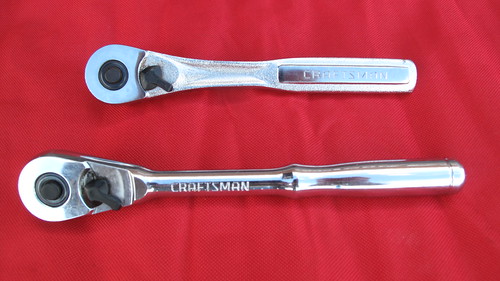 Standard Craftsman ratchet, top, fully polished, bottom. Both unfortunately have plastic selector levers, but are solid tools. The standard ratchet is now made in China.
Standard Craftsman ratchet, top, fully polished, bottom. Both unfortunately have plastic selector levers, but are solid tools. The standard ratchet is now made in China.
For several decades I relied on Craftsman ratchets and wrenches, with only a scant few split sockets to their discredit during field repairs (replaced with no questions asked at Sears . . . after I got home of course). Recently I decided to up the ante. I started haunting eBay, looking at Snap-on socket and wrench sets. There were a few decent deals, but nothing spectacular—until I realized that the sets on offer that were missing a piece or two went for much less than the complete sets. Soon I snagged a lot of current-production 1/2-inch sockets, from 12mm all the way up to a giant 36mm, missing only a 19mm, which I quickly added on an individual auction. Same thing with a wrench set from 6mm to 30mm, missing the 14 and 17, again easily replaced.
My one retail splurge was the 1/2-inch ratchet handle. I consider this the single most critical tool in my kit. If I break out the 1/2-inch sockets, it’s usually because something significant has gone wrong with either my own vehicle or someone else’s. And if your ratchet handle breaks removing the 21mm bolts from a transmission bell housing, you can bet you won’t be getting them off with a pair of Vise-grips. So I went to the Snap-on website and plunked down $164.95 for part number SF80A: an 18-inch-long, flex-handle ratchet with a Swiss-watch-smooth 80-tooth mechanism—astonishing on a ratchet with a foot and a half of leverage, but Snap-on uses the same head on a 24-inch handle, so they obviously have confidence in it. The locking flex head gives this ratchet great flexibility, the length makes it an effective breaker bar for the tightest bolts, and the fine-toothed mechanism requires only 4.5 degrees of swing to engage the next tooth, a boon in restricted quarters. Every time I use it I’m impressed, and swear it makes me a better mechanic than I really am. It certainly makes me look like a better mechanic than I am.
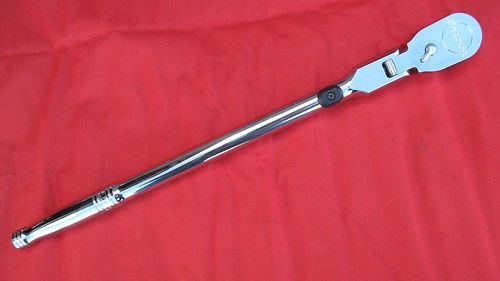 Worth every penny: The Snap-on SF80A 1/2-inch ratchet.
Worth every penny: The Snap-on SF80A 1/2-inch ratchet.
With these two fine sets in hand, I began contemplating my entire traveling tool kit. Specifically, I started musing on a question that had been at the back of my mind for some time: Would it be possible to assemble a high-quality tool kit that could handle virtually any field repair up to and including such things as clutch or differential replacement, suspension work, hub disassembly, or cylinder-head removal—in other words, the types of repairs one might expect on an extended overland trip in remote areas—yet still fit inside one manageable case?
Interesting idea. Time to look at some Pelican cases.
Next: a compact, high-quality 3/8ths-inch socket set. Read part 2 HERE.
Hint: When using “Search,” if nothing comes up, reload the page, this usually works. Also, our “Comment” button is on strike thanks to Squarespace, which is proving to be difficult to use! Please email me with comments!
Overland Tech & Travel brings you in-depth overland equipment tests, reviews, news, travel tips, & stories from the best overlanding experts on the planet. Follow or subscribe (below) to keep up to date.
Have a question for Jonathan? Send him an email [click here].
SUBSCRIBE
CLICK HERE to subscribe to Jonathan’s email list; we send once or twice a month, usually Sunday morning for your weekend reading pleasure.
Overland Tech and Travel is curated by Jonathan Hanson, co-founder and former co-owner of the Overland Expo. Jonathan segued from a misspent youth almost directly into a misspent adulthood, cleverly sidestepping any chance of a normal career track or a secure retirement by becoming a freelance writer, working for Outside, National Geographic Adventure, and nearly two dozen other publications. He co-founded Overland Journal in 2007 and was its executive editor until 2011, when he left and sold his shares in the company. His travels encompass explorations on land and sea on six continents, by foot, bicycle, sea kayak, motorcycle, and four-wheel-drive vehicle. He has published a dozen books, several with his wife, Roseann Hanson, gaining several obscure non-cash awards along the way, and is the co-author of the fourth edition of Tom Sheppard's overlanding bible, the Vehicle-dependent Expedition Guide.









